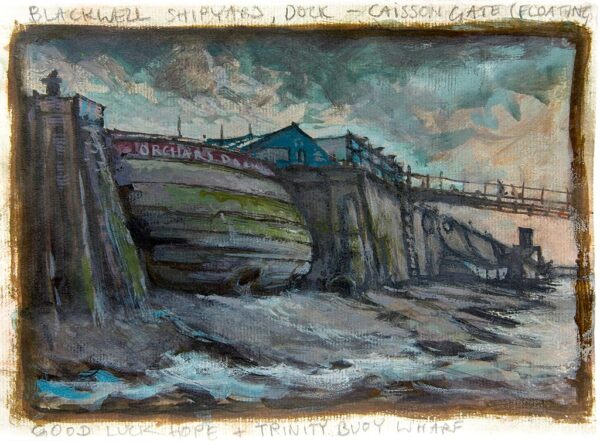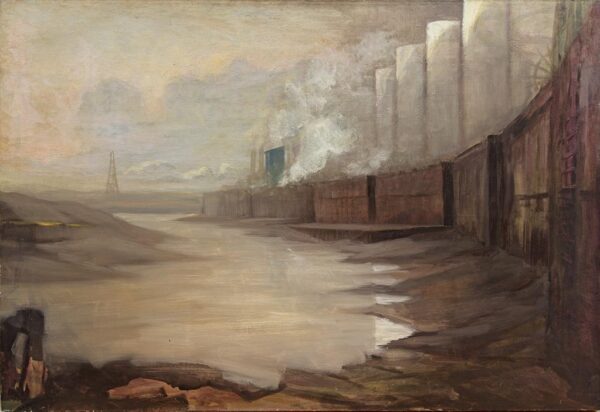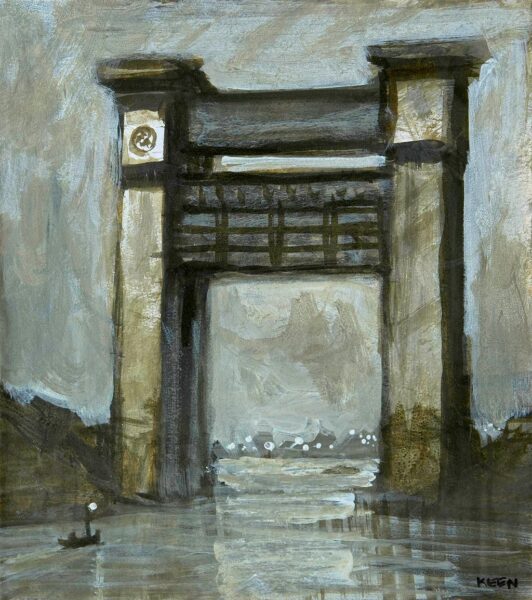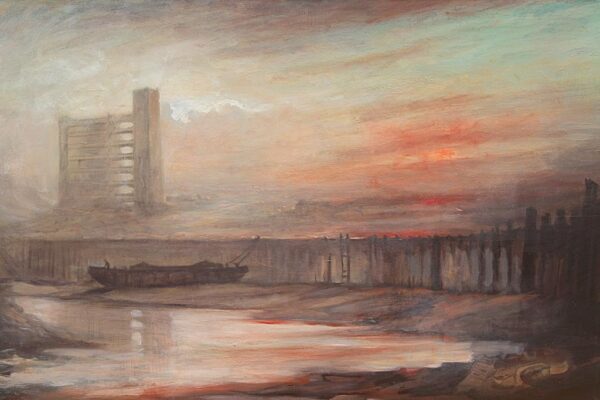Anna Keen is Wandering the Wilderness for the Totally Thames Festival 2022 in Trinity Buoy Wharf, near Docklands. Her ART Road-Signs are waypoints set outside in the landscape, at this magnificent confluence of the river Lea and the river Thames.
Opening hours: daily 7 am – 7 pm
Address: 64 Orchard Place, Poplar, London, E14 0JW (directions)

A caisson is a form of lock gate. It consists of a large floating iron or steel box. This can be flooded to seat the caisson in the opening of the dock to close it, or pumped dry to float it like a boat and allow it to be towed clear of the dock.

Pura Foods’ used to be called the ‘Pure Lard Company’. This huge factory full of steaming and smoking chimneys, creaked, groaned, whistled and hummed, bustling right up to the edges of what is now called ‘London City Island’. It covered the whole loop and was built upon the ghostly vats of boiling blubber brought up The Thames by the the Greenland Whalers.

Vic 56 was the last steam tug on the Thames and a Dunkirk Little Ship. Technically a steam coasting lighter or a “puffer”. She is one of the 98 Victualling Inshore Craft built to the orders of the ministry of war transport between 1941 and 1945. There are no modern navigational aids, apart form the VHF radio which is essential on the Thames. VIC 56 never possessed radar or an echo sounder. She was moored at Trinity Buoy Wharf when I was there 20 years ago, and I sailed in her, watching the blackened, sweating men shovel rugby ball size pieces of Polish coal into her fiery boiler as she silently steamed upriver. The only noise was the long lamenting whistle as she ’let off steam’. In 1961 VIC 56 was selected to carry a jeep, sectioned hut and stores to the uninhabited island of South Rona in the inner Hebrides. It was the first stage in establishing an acoustic signature monitoring station still critical to today’s Royal Navy. The hold, engine room and cabins are unaltered since naval service – VIC 56 is the only VIC vessel to survive in this condition.

The Thames Barrier spans 520 metres across the River Thames near Woolwich with 10 steel gates that can be raised into position across the River Thames. When raised, the main gates stand as high as a 5 storey building and as wide as the opening of Tower Bridge. Each main gate weighs 3,300 tonnes.The Environment Agency receives information on potential tidal surges from weather satellites, oil rigs, weather ships and coastal stations. They can forecast dangerous conditions up to 36 hours in advance. The barrier will close just after low tide, or about 4 hours before the peak of the incoming tide surge reaches the barrier. Information comes from a range of mathematical computer models that forecast expected sea and river levels. This is supplemented by data from the Met Office and real-time information provided by the UK National Tidegauge Network This hydrological and meteorological data is fed into the control room every minute from a wide network of tide and river pressure and wind gauges. The barrier has no individual trigger level for closure. The closing process is guided by a mathematical matrix that considers the river flow, tide and surge at the time. The final decision for closure lies with the Thames Barrier Duty Controller.

The Dome is visible from space. The roof and its supports together weigh less than the air inside. Located on Greenwich Marsh, the windswept peninsular was once a vast former gasworks. In 1988 contaminants were found including solid ferrous cyanide, coal tars, mineral oils, benzene, polychromatic hydrocarbons, phenols, foul lime (from passing gas through crushed chalk for purification) and heavy metals.

The River Roding is tidal from the Barking Barrage weir to the end of the river where it is known as Barking Creek. Here it joins The Thames and is part of the flood defence system for London as well as protecting Barking. It is normally closed before the Thames barrier. Completed in 1983, it is about 60 metres high (it needed to be this size to allow shipping to reach the Town Quay in Barking further upstream). In the 1850s the creek was home to England’s largest fishing fleet. The fish were landed at the Town Quay and stored in ice houses prior to being transferred to London’s fish markets. It is where the largest Sewage works in Europe unleashes its ‘outfall’ into The Thames.

Walbrook Wharf is the ancient confluence of the Sacred River Walbrook which still runs beneath the City of London albeit in a culverted storm and sewage sewer whose outlet is at the foot of Cory’s Rubbish Barges, close to Tower Bridge. In total, Cory operates a fleet of five tugs, more than 50 barges and in excess of 1,500 containers. This fleet is used to transport non-recyclable waste from waste transfer stations along the River Thames to Cory’s energy from waste facility in Belvedere. These same barges and tugs also transport the ash resulting from the energy recovery process further down the Thames to Tilbury where it is processed into aggregate for the construction industry. This use of the river removes around 100,000 vehicle journeys from London’s roads each year. The name Cory has Greek origins and is the maiden name of the goddess Persephone, the wife of Hades, king of the underworld. The story is told of how Persephone was gathering flowers in the Vale of Nysa when she was seized by Hades and removed to the underworld. Upon learning of the abduction, her mother, Demeter, in her misery, became unconcerned with the harvest or the fruitfulness of the earth, so that widespread famine ensued. Zeus therefore intervened, commanding Hades to release Cory Persephone to her mother. But because she had eaten a single pomegranate seed in the underworld, however, she could not be completely freed but had to remain one-third of the year with Hades. The name may also have origins from the Gaelic word coire, which means “in a cauldron”, or “in a hollow”.
Trinity Lighthouse was built in 1864. This experimental lighthouse was used to train lighthouse keepers and test new lighthouse technology, not as a navigational aid. Originally, moored alongside was the Trinity House Yacht which serviced and maintained the buoys. In 1869 Trinity House set up an engineering establishment to test and repair new iron buoys. By 1875 the works had extended into the neighbouring property that had previously been the Green’s Shipyard site.
The depot was responsible for supplying and maintaining navigation buoys and lightships between Southwold and Dungeness.The depot closed on 3rd December 1998 when the London Docklands Development Corporation purchased the site. Urban Space Management took on the site as a long term lease in the same year. Trinity Buoy Wharf is now an arts and culture venue and hosts Longplayer, a thousand year long musical composition, which began playing at on 31st December 1999. Moored alongside is LV95 Lightvessel, a recording studio and in the past LV93 was also moored there, before moving to the Royal Docks. Bow Creek is one of the names given to the last two and a half miles of the river Lea before it enters The Thames beside Trinity Buoy Wharf Once a busy waterway full of barges trading with mills, warehouses and factories along the river bank, The river Lea is one of the oldest navigational routes in the country, its records date back to 1190. In 1665 the river bargemen were given the right to access the Thames without help from the Thames Lightermen in recognition of the bravery they had shown bringing food to London during the Plague.
A ‘London City Island’ mysteriously appeared one day in ‘real state rebranding’ in Bow Creek, on the double hairpin bend of the river Lea. Tightly packed skyscrapers have replaced the oil and fat factory ‘Pura Food’ which used to be called the ‘Pure Lard Company’. This huge factory, full of steaming and smoking chimneys, creaked, groaned, whistled and hummed right up to the edge of the ‘island’ like demented inmates of Alcatraz waiting for the chance to escape.
It covered the whole loop of London City Island and was built upon the ghostly vats of boiling blubber brought up The Thames by the the Greenland Whalers. English National Ballet dancers now leap and pirouette beside the “hardly human, incarnate mushrooms” as the locals were described by father Lawless in Booth’s Enquires into ‘The religious life of London’ in 1904.
Strangely, this iconic double loop does not even exist on an old map of the 1700’s, it is just marked as Abbey Marsh and the Plaistow Levels. ‘Orchard House’ with its trees surrounded by a ring-ditch is also marked next to where Trinity Buoy Wharf is now. The only other notation nearby on that map was ‘Copperas House’ and another huge factory complex. Copperas is produced from pyrite in coal and iron. The green crystals of hydrated ferrous sulphate is also known as Green Vitriol. Pyrite has been used since classical times to manufacture copperas. Iron pyrite was heaped up and allowed to weather (an example of an early form of heap leaching). The acidic runoff from the heap was then boiled with iron to produce iron sulfate. Vitriolic waters can produce both green vitriol (sulfate of iron), and blue vitriol (sulfate of copper). This bluish-green crystalline compound is used in sewage and water treatment and as a pigment and fertilizer. It is also used in medicine to treat iron deficiency. In the eighteenth century vitriol was needed for manufacturing chemicals like nitric and hydrochloric acids, and in an early industrial process for making washing soda. Hydrochloric acid was the starting point for chlorine production and the gas made was in turn used in a textile bleaching process. The synthesis of important fertilisers in the nineteenth century, like ammonium sulphate and super-phosphate, required large amounts of sulphuric acid. I distinctly remember the curious, oily smell which was oddly comforting, smearing itself on the back of my throat 20 odd years ago as I walked down to my little boat and studio at TBW. I wondered why there were massive black tanks with skulls and crossbones, dead fish and trees drawn upon them, until I read of the reaction between sulphuric acid and vegetable oils, which is quite complex, but renders them transparent.
E14 0JW London
United Kingdom


